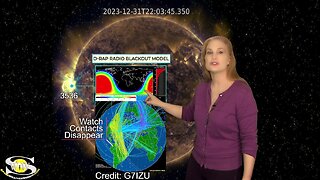Premium Only Content

Two Solar Cycles at Once & A Big Meteor Nearly Hits | Space Weather News 10.10.2019
This episode of Weather News is sponsored in part by 3ric Johanson: http://instagram.com/scubist
Our Sun keeps our attention focused even though space weather remains reasonably quiet this week. We have had several bright regions appear in Earth-view. The largest of these regions was strong enough to be officially designated as a sunspot (region 2749) from Solar Cycle 24. But then two high latitude bright regions emerged, one in the north and one in the south. These two regions both had Solar Cycle 25 polarity, which means this is one of the rare moments when we have active regions from two different solar cycles in both the northern and southern hemispheres in view at the same time! Unfortunately, if you blinked, you missed this rarity, as the new regions faded quite quickly. As a result, the solar flux has remained low and radio propagation continues to be poor on Earth's dayside. We do have a remnant coronal hole rotating through the Earth-strike zone now. Its been sending us some sporadic fast solar wind, which has bumped us up to active conditions sporadically. However, aurora views are expected to be sporadic and elusive, especially at mid-latitudes. Take a closer look at the ongoing solar activity, including the new active regions, see how the fast solar wind hitting now will affect you, and learn about the meteor that nearly hit the ground in Southern California this week!
Want early access to these forecasts and more? Join me at:
http://patreon.com/spaceweatherwoman
For daily and often hourly updates (during active times) visit me on Twitter:
https://twitter.com/TamithaSkov
For a more in-depth look at the data and images highlighted in this video see these links below.
Solar Imaging and Analysis:
SDO: http://sdo.gsfc.nasa.gov/data/
Helioviewer: http://www.helioviewer.org/
Flare Analysis: http://www.lmsal.com/solarsoft/latest_events/
Computer Aided CME Tracking CACTUS: http://www.sidc.oma.be/cactus/out/latestCMEs.html
GOES Xray: http://www.swpc.noaa.gov/rt_plots/xray_1m.html
SOHO: http://sohodata.nascom.nasa.gov/
Stereo: http://stereo.gsfc.nasa.gov/
GONG magnetic field synoptic movie: https://gong.nso.edu/data/magmap/standard_movie.html
GONG magnetic field synoptic charts: http://gong.nso.edu/data/magmap/
LMSAL Heliophysics Events HEK http://www.lmsal.com/isolsearch
Solar Wind:
DISCOVR solar wind: http://www.swpc.noaa.gov/products/real-time-solar-wind
ACE Solar Wind: http://www.swpc.noaa.gov/products/ace-real-time-solar-wind
NASA ENLIL SPIRAL: https://iswa.gsfc.nasa.gov/IswaSystemWebApp/iSWACygnetStreamer?timestamp=2038-01-23+00%3A44%3A00&window=-1&cygnetId=261
NOAA ENLIL SPIRAL: http://www.swpc.noaa.gov/products/wsa-enlil-solar-wind-prediction
Magnetosphere, Ionosphere, Atmosphere:
GOES Magnetometer: http://www.swpc.noaa.gov/products/goes-magnetometer
Ionosphere D-Region Absorption (DRAP) model: http://www.swpc.noaa.gov/products/d-region-absorption-predictions-d-rap/
Auroral Oval Ovation Products: http://www.swpc.noaa.gov/products/aurora-30-minute-forecast
Global 3-hr Kp index: http://www.swpc.noaa.gov/products/planetary-k-index
Wing Kp index prediction: http://www.swpc.noaa.gov/products/wing-kp
USGS Ground Magnetometers: http://geomag.usgs.gov/realtime/
USGS Disturbance Storm-Time (Dst): http://geomag.usgs.gov/realtime/dst/
NAIRAS Radiation Storm Model: http://sol.spacenvironment.net/raps_ops/current_files/globeView.html
Multi-Purpose Space Environment Sites:
NOAA/SWPC: http://www.swpc.noaa.gov
SOLARHAM: http://www.solarham.net/index.htm
Spaceweather: http://spaceweather.com
iSWA: http://iswa.gsfc.nasa.gov/iswa/iSWA.html
Definition of Geomagnetic Storm, Radiation Storm, and Radio Blackout Levels:
http://www.swpc.noaa.gov/NOAAscales/
None of this would be possible without the hard work and dedication of those who have provided all of this data for public use.
Images c/o NASA/ESA/CSA (most notably the superb SDO, SOHO, ACE, STEREO, CCMC, JPL & DSN teams, amazing professionals, hobbyists, institutions, organizations, agencies and amateurs such as those at the USAF/HAARP, NICT, NOAA, USGS, Environment Canada, Natural Resources Canada, Intellicast, Catatania, rice.edu, wisc.edu, sonoma.edu ucalgary.ca, rssi.ru, ohio-state.edu, solen.info, and more. Thanks for making Space Weather part of our every day dialogue.
-
 12:43
12:43
Dr. Tamitha Skov
1 year ago $0.22 earnedBiggest X-Flare of Cycle 25 & Super Storm Launch | Space Weather Spotlight 02 January 2024
585 -
 2:04:52
2:04:52
Kim Iversen
9 hours agoElon's Pumping Out Babies Like They're Tesla Model 3's | EU Panics Over Peace Talks, Wants More War
117K117 -
 1:05:35
1:05:35
Man in America
12 hours agoFort Knox & Trump’s Secret Gold Move—The Financial Reset NO ONE Is Ready For?
69.5K39 -
 2:21:20
2:21:20
Robert Gouveia
9 hours agoTrump Goes to SCOTUS! Judge CAVES on DOGE? Fani Willis Not Happy!
96.3K29 -
 20:41
20:41
Stephen Gardner
9 hours ago🔥You Won't BELIEVE What JUST Happened To Don Trump Jr.!!
98.4K135 -
 58:00
58:00
The StoneZONE with Roger Stone
7 hours agoEuropean Leaders Resist Trump Peace Overtures To Their Own Demise | The StoneZONE w/ Roger Stone
68.8K11 -
 9:29
9:29
AlaskanBallistics
8 hours ago $5.74 earnedWyoming Suppressors and Rifles at Shot Show 2025
73.9K4 -
 1:06:40
1:06:40
Donald Trump Jr.
12 hours agoThe Left is Taking one L After Another, Live with Michael Knowles | Triggered Ep. 217
167K110 -
 47:17
47:17
Kimberly Guilfoyle
12 hours agoWoke Gets DOGE’d, Live with AJ Rice & Jarrett Stepman | Ep. 197
124K42 -
 20:11
20:11
Candace Show Podcast
11 hours agoBecoming Brigitte: Candace Owens x Xavier Poussard | Ep 6
186K327